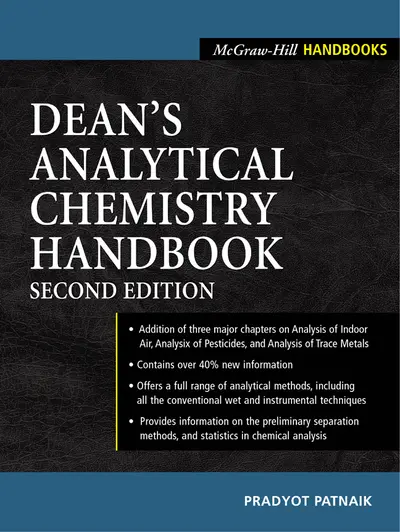My Account Details

ISBN10: 0071410600 | ISBN13: 9780071410601

Step 1 . Download Adobe Digital Editions to your PC or Mac desktop/laptop.
Step 2. Register and authorize your Adobe ID (optional). To access your eBook on multiple devices, first create an Adobe ID at account.adobe.com. Then, open Adobe Digital Editions, go to the Help menu, and select "Authorize Computer" to link your Adobe ID.
Step 3. Open Your eBook. Use Adobe Digital Editions to open the file. If the eBook doesn’t open, contact customer service for assistance.
Publisher's Note: Products purchased from Third Party sellers are not guaranteed by the publisher for quality, authenticity, or access to any online entitlements included with the product. THE MOST USEFUL TOOL IN ANALYTICAL CHEMISTRY This comprehensive, up-to-date reference offers chemists and chemical engineers detailed coverage of the full range of analytical methods, including all conventional wet and instrumental techniques. It also provides information on the preliminary operations of analysis, preliminary separation methods, quality control and quality assurance, and statistics in chemical analysis. This one-of-a-kind resource presents fundamental data on: Volumetric and Gravimetric Analysis Chromatographic Methods Electronic Absorption and Luminescence Spectroscopy Infrared and Raman Spectroscopy Atomic Spectroscopy Optical Activity and Rotary Dispersion Refractometry X-ray Methods Radiochemical Methods Nuclear Magnetic Resonance Spectroscopy and Electron Spin Resonance Mass Spectrometry Electroanalytical Methods Thermal Analysis Magnetic Susceptibility Organic Fundamental Analysis Detection and Determination of Functional Groups in Organic Compounds Methods of Determination in Water Geological and Inorganic Materials Statistics in Chemical Analysis Water Analysis More NEW CHAPTERS ON: * Analysis of Indoor Air * Pesticide and Herbicide Analysis * Environmental Analysis Including Trace Updates on Processes, Tools, and Techniques
Chapter 1.1: SAMPLINGChapter 1.2: MIXING AND REDUCTION OF SAMPLE VOLUMEChapter 1.3: CRUSHING AND GRINDINGChapter 1.4: SCREENING AND BLENDINGChapter 1.5: MOISTURE AND DRYINGChapter 1.6: THE ANALYTICAL BALANCE AND WEIGHTSChapter 1.7: METHODS FOR DISSOLVING THE SAMPLEChapter 1.8: FILTRATIONChapter 1.9: SPECIFICATIONS FOR VOLUMETRIC WARE
Chapter 1.3: CRUSHING AND GRINDINGChapter 1.4: SCREENING AND BLENDINGChapter 1.5: MOISTURE AND DRYINGChapter 1.6: THE ANALYTICAL BALANCE AND WEIGHTSChapter 1.7: METHODS FOR DISSOLVING THE SAMPLEChapter 1.8: FILTRATIONChapter 1.9: SPECIFICATIONS FOR VOLUMETRIC WARE
Chapter 1.5: MOISTURE AND DRYINGChapter 1.6: THE ANALYTICAL BALANCE AND WEIGHTSChapter 1.7: METHODS FOR DISSOLVING THE SAMPLEChapter 1.8: FILTRATIONChapter 1.9: SPECIFICATIONS FOR VOLUMETRIC WARE
Chapter 1.7: METHODS FOR DISSOLVING THE SAMPLEChapter 1.8: FILTRATIONChapter 1.9: SPECIFICATIONS FOR VOLUMETRIC WARE
Chapter 1.9: SPECIFICATIONS FOR VOLUMETRIC WARE
Need support? We're here to help - Get real-world support and resources every step of the way.